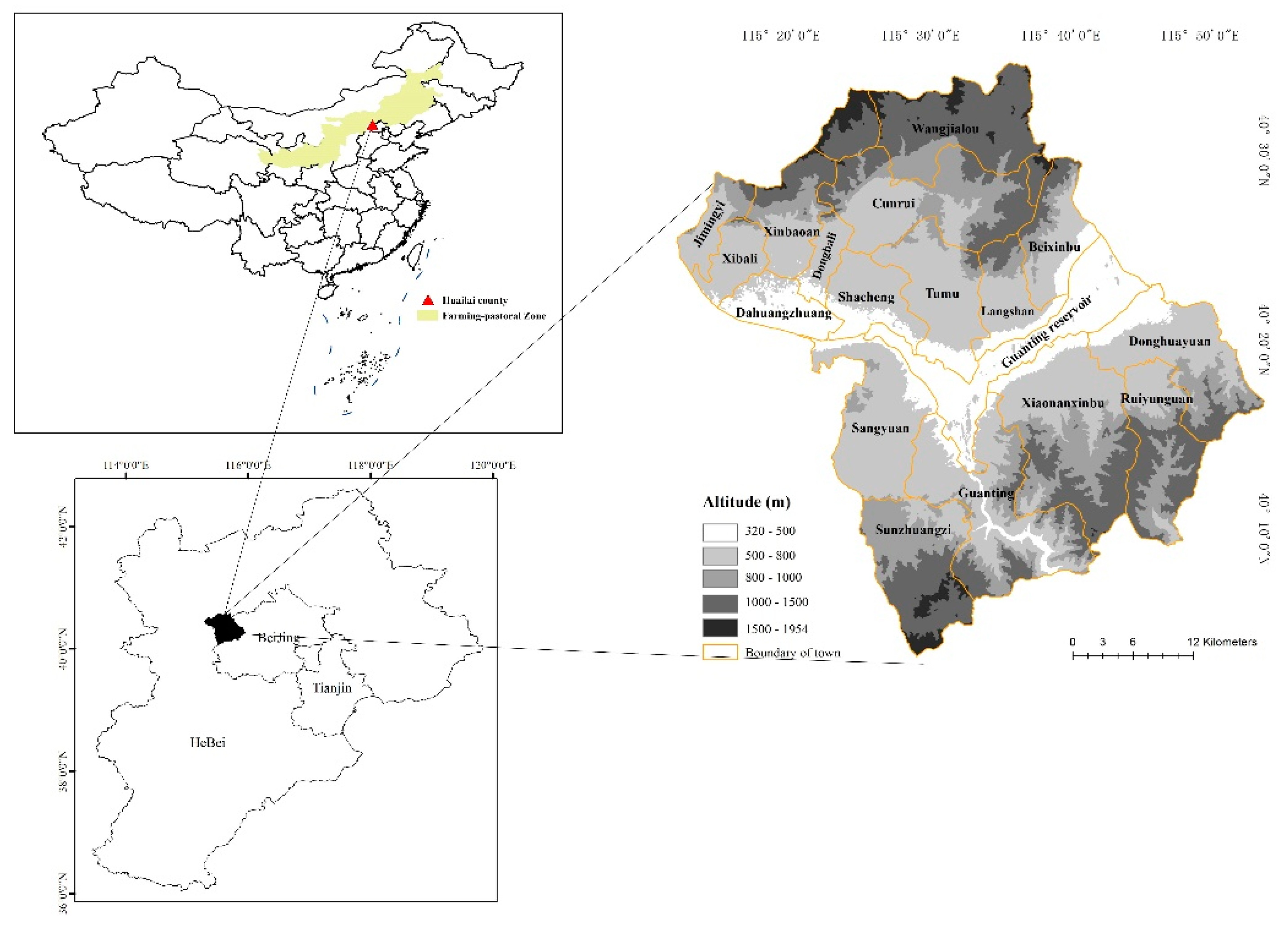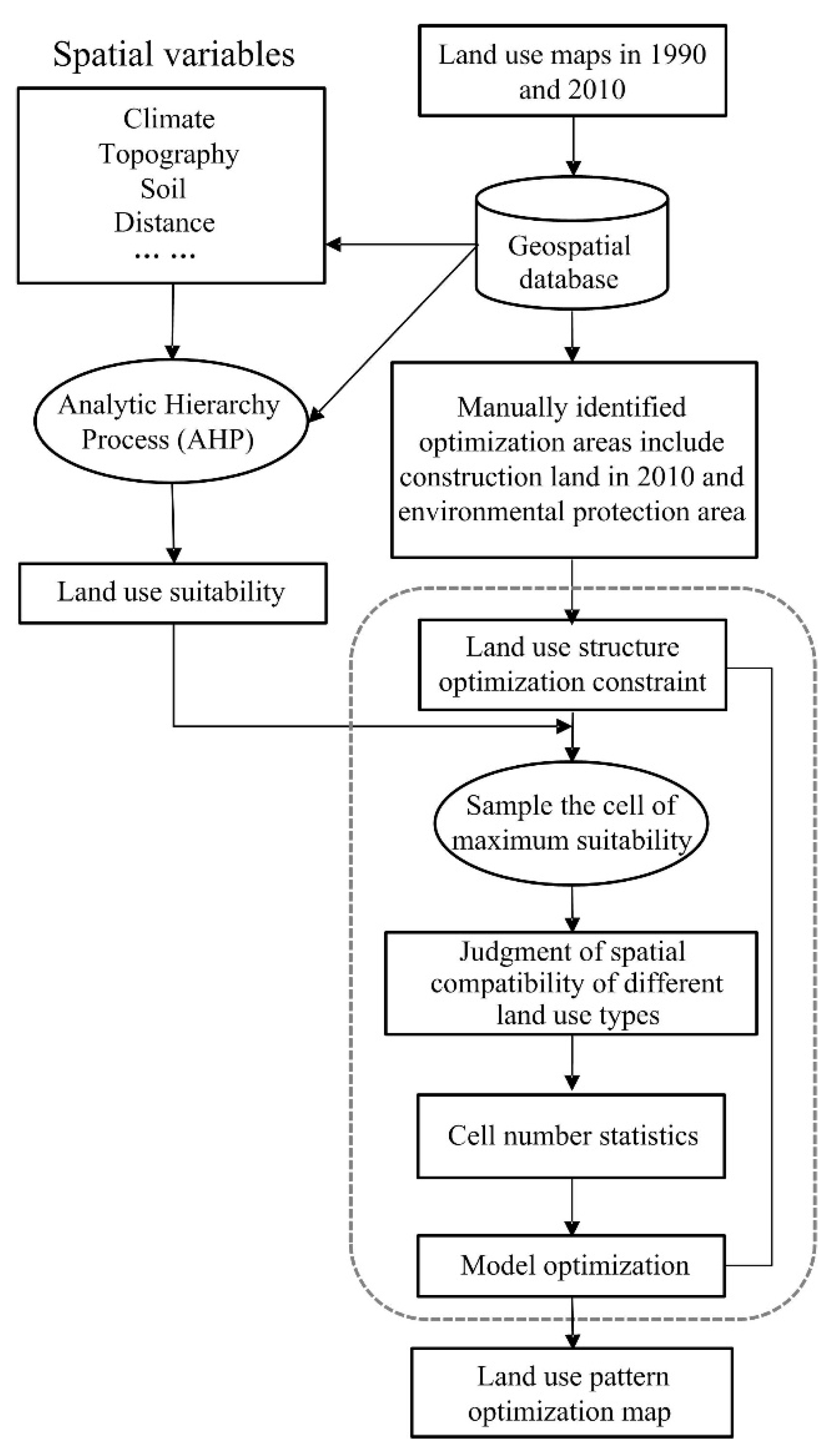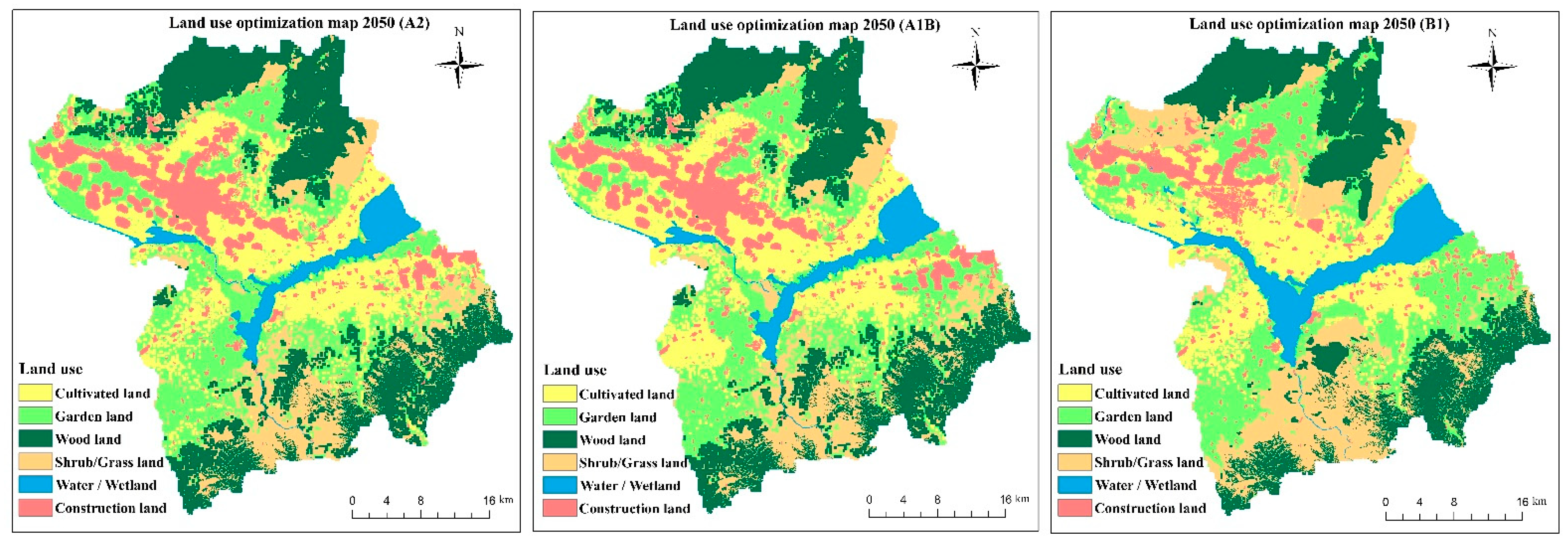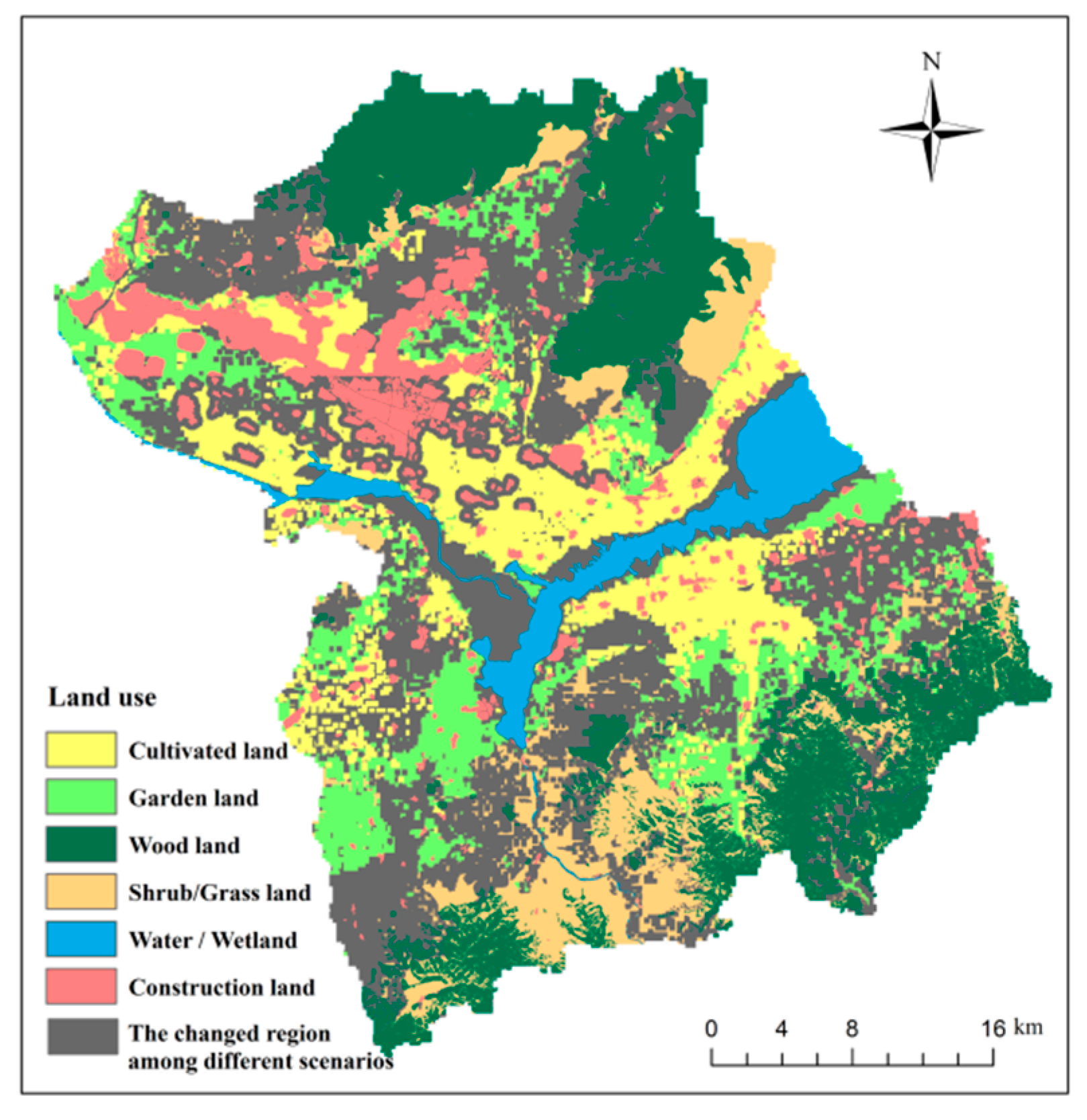Integrating Climate Change Adaptation and Mitigation into Land Use Optimization: A Case Study in Huailai County, China
Abstract
:1. Introduction
2. Materials and Methods
2.1. Modelling Framework
2.2. Study Area
2.3. Climate Change Scenarios
2.4. Data Collection
2.5. Modeling Parameterizations of Climate Change Adaptation and Mitigation
2.5.1. Carbon Sequestration
2.5.2. Social Adaptation
2.5.3. Available Water Resources
2.5.4. Land Use Suitability
2.6. Modeling for Land Use Optimization
2.6.1. Land Use Structure Optimization
- (1)
- We established the constraint condition of cultivated land based on the population and food demand. In the A2 and A1B scenarios (high population growth), population was predicted as 427,574 in 2050; in the B1 scenario (slower growth rate), the population was predicted as 397,400 in 2050. Then we used the nutritional index reference (400 kg per capital every year as proposed by Food and Agriculture Organization of the United Nations) to calculate the minimum food demand of different scenarios. Finally, based on the cultivated land yield we obtained the minimum demand of cultivated land as follows:
- (2)
- Based on the development description of different scenarios (Table 1), we proposed that the increase rate of construction land for A2, A1B, and B1 scenarios were 2%, 1.5%, and 1.0%, respectively. The constraint conditions are then established as follows:
- (3)
- The environmental protection policies were different between the three scenarios; B1 scenarios increasingly focused on environmental protection although A2 and A1B scenarios ignored these. Based on the above environmental protection background, we established the woodland, shrub/grassland, and water constraint conditions.
- (1)
- Based on numerous agroecological parameters, Zhang and Tang developed landscape pattern optimization research in the study area and proposed that cultivated land, garden land, and shrub/grassland should be located at the valley plain and low hilly areas [41]. Statistical results indicated that the total area of the region is 132,843 ha. Considering that construction land and water area were also primarily distributed in this region, we deducted these areas and obtained the area of cultivated land, garden land, and shrub/grassland located at the valley plain and low hilly areas. The constraint conditions can be expressed as follows:
- (2)
- Zhong proposed that the garden land of the study area should not exceed 43,335 ha based on the water consumption analysis [42], and thus, the constraint condition can be established as follows:The optimized land use structure was determined using LINGO 10.0 software.
2.6.2. Land Use Pattern Optimization
- (1)
- Compatibility matrix. The value of spatial compatibility corresponds to 0 or 1 where 1 denotes the compatibility between the neighboring two land use types (generally adjacent to each other), and 0 denotes no compatibility (generally isolated from each other).
- (2)
- Cell number statistics. The rule of surrounding land use requires that the number of the cell belonging to optimized land use should exceed that of the other land use types.
3. Results
3.1. Land Use Structure Optimization Result
3.2. Land Use Pattern Optimization Results
4. Discussion
4.1. Incorporating Climate Change Adaptation and Mitigation into Land Use Planning
4.2. Modeling Study of Land Use Optimization Integrated Climate Change Adaptation and Mitigation in the Future
4.3. Climate Change Adaptation and Mitigation Strategies in Land Use Management
5. Conclusions
- (1)
- The results indicated that rational adjustments of land use structure and pattern can be an effective strategy to adapt and mitigate climate change at a regional scale in the face of the changing climate. In addition, the present findings revealed that trade-offs exist between climate change adaptation and mitigation. Ultimately, land use planning and policy should jointly consider adaptation and mitigation to cope with climate change and to achieve sustainability. Furthermore, it is necessary to develop methodology to minimize trade-offs between adaptation and mitigation and then achieve maximum efficiency results.
- (2)
- The study area corresponded to a typical mountain–basin system wherein the optimized land use pattern characteristics including the following: cultivated land, construction land and most of garden land located in the plain of the study area, a small part of garden land and most of shrub/grassland located in the hills, and the woodland primarily located in the mountainous area. In addition, the changed land use region with different climate change scenarios was primarily located in the transition region of three topography regions (plain, hills, and mountain). In the region, the major changed land use types included shrub/grassland, garden land, and woodland. Considering the topographical characteristics of the study area, it is important to extend the methodology to other regions.
Author Contributions
Funding
Data Availability Statement
Acknowledgments
Conflicts of Interest
References
- Demirkesen, A.C.; Evrendilek, F. Compositing climate change vulnerability of a Mediterranean region using spatiotemporally dynamic proxies for ecological and socioeconomic impacts and stabilities. Environ. Monit. Assess. 2016, 189, 29. [Google Scholar] [CrossRef]
- Allan, R.P.; Soden, B. Atmospheric Warming and the Amplification of Precipitation Extremes. Science 2008, 321, 1481–1484. [Google Scholar] [CrossRef] [Green Version]
- Diffenbaugh, N.S.; Scherer, M.; Trapp, R.J. Robust increases in severe thunderstorm environments in response to greenhouse forcing. Proc. Natl. Acad. Sci. USA 2013, 110, 16361–16366. [Google Scholar] [CrossRef] [PubMed] [Green Version]
- Mu, J.E.; Wein, A.M.; McCarl, B.A. Land use and management change under climate change adaptation and mitigation strategies: A U.S. case study. Mitig. Adapt. Strat. Glob. Chang. 2015, 20, 1041–1054. [Google Scholar] [CrossRef]
- Wilbanks, T.J.; Kane, S.M.; Leiby, P.N.; Perlack, R.D.; Settle, C.; Shogren, J.F.; Smith, J.B. Possible Responses to Global Climate Change: Integrating Mitigation and Adaptation. Environ. Sci. Policy Sustain. Dev. 2003, 45, 28–38. [Google Scholar] [CrossRef]
- Duguma, L.A.; Minang, P.A.; van Noordwijk, M. Climate change mitigation and adaptation in the land use sector: From com-plementarity to synergy. Environ. Manag. 2014, 54, 420–432. [Google Scholar] [CrossRef] [Green Version]
- UN/ISDR. Global Assessment Report on Disaster Risk Reduction: Revealing Risk, Redefining Development; United Nations Publication: London, UK, 2011. [Google Scholar]
- Chuai, X.; Huang, X.; Lai, L.; Wang, W.; Peng, J.; Zhao, R. Land use structure optimization based on carbon storage in several regional terrestrial ecosystems across China. Environ. Sci. Policy 2013, 25, 50–61. [Google Scholar] [CrossRef]
- Lei, Y.; Wang, J.; Yue, Y.; Yin, Y.; Sheng, Z. How adjustments in land use patterns contribute to drought risk adaptation in a changing climate—A case study in China. Land Use Policy 2014, 36, 577–584. [Google Scholar] [CrossRef]
- Parmesan, C. Ecological and Evolutionary Responses to Recent Climate Change. Annu. Rev. Ecol. Evol. Syst. 2006, 37, 637–669. [Google Scholar] [CrossRef] [Green Version]
- Correia, R.A.; Bugalho, M.N.; Franco, A.M.A.; Palmeirim, J.M. Contribution of spatially explicit models to climate change adaptation and mitigation plans for a priority forest habitat. Mitig. Adapt. Strat. Glob. Chang. 2018, 23, 371–386. [Google Scholar] [CrossRef] [Green Version]
- Metz, B.; Davidson, O.; Bosch, P.; Dave, R.; Meyer, L. Climate Change 2007: Mitigation of Climate Change; Cambridge University Press: New York, NY, USA, 2007. [Google Scholar]
- Golub, A.; Hertel, T.; Lee, H.-L.; Rose, S.; Sohngen, B. The opportunity cost of land use and the global potential for greenhouse gas mitigation in agriculture and forestry. Resour. Energy Econ. 2009, 31, 299–319. [Google Scholar] [CrossRef] [Green Version]
- Herrero, M.; Thornton, P.K.; Gerber, P.; Reid, R.S. Livestock, livelihoods and the environment: Understanding the trade-offs. Curr. Opin. Environ. Sustain. 2009, 1, 111–120. [Google Scholar] [CrossRef]
- Bailis, R.; McCARTHY, H. Carbon impacts of direct land use change in semiarid woodlands converted to biofuel plantations in India and Brazil. GCB Bioenergy 2011, 3, 449–460. [Google Scholar] [CrossRef]
- Rojas-Downing, M.M.; Nejadhashemi, A.P.; Harrigan, T.; Woznicki, S. Climate change and livestock: Impacts, adaptation, and mitigation. Clim. Risk Manag. 2017, 16, 145–163. [Google Scholar] [CrossRef]
- Montanaro, G.; Nuzzo, V.; Xiloyannis, C.; Dichio, B. Climate change mitigation and adaptation in agriculture: The case of the olive. J. Water Clim. Chang. 2018, 9, 633–642. [Google Scholar] [CrossRef]
- Niles, M.T.; Brown, M.; Dynes, R. Farmer’s intended and actual adoption of climate change mitigation and adaptation strategies. Clim. Chang. 2015, 135, 277–295. [Google Scholar] [CrossRef] [Green Version]
- Gregório, V.; Simoes, S.; Seixas, J. Trade-Offs between Climate Change Adaptation and Mitigation Options for Resilient Cities: Thermal Comfort in Households. In Innovation in Climate Change Adaptation; Leal Filho, W., Ed.; Springer International Publishing: Cham, Switzerland, 2016; pp. 113–129. [Google Scholar]
- Pietrapertosa, F.; Salvia, M.; De Gregorio Hurtado, S.; D’Alonzo, V.; Church, J.M.; Geneletti, D.; Musco, F.; Reckien, D. Urban climate change mitigation and adaptation planning: Are Italian cities ready? Cities 2019, 91, 93–105. [Google Scholar] [CrossRef]
- Parker-Flynn, J.E. Linking Mitigation and Adaptation to Climate Change. Am. J. Public Health 2018, 108, S58–S59. [Google Scholar] [CrossRef]
- Landauer, M.; Juhola, S.; Klein, J. The role of scale in integrating climate change adaptation and mitigation in cities. J. Environ. Plan. Manag. 2018, 62, 741–765. [Google Scholar] [CrossRef] [Green Version]
- Lungarska, A.; Chakir, R. Climate-induced Land Use Change in France: Impacts of Agricultural Adaptation and Climate Change Mitigation. Ecol. Econ. 2018, 147, 134–154. [Google Scholar] [CrossRef] [Green Version]
- Cao, Q.; Yu, D.; Georgescu, M.; Han, Z.; Wu, J. Impacts of land use and land cover change on regional climate: A case study in the agro-pastoral transitional zone of China. Environ. Res. Lett. 2015, 10, 124025. [Google Scholar] [CrossRef]
- Xu, Y.; Tang, H. Characteristics and impacts of climate change in Huailai Basin during the past 60 years. J. Beijing Norm. Univ. Nat. Sci. 2015, 51, 293–298. [Google Scholar]
- Wang, B.; Tang, H.; Xu, Y. Integrating ecosystem services and human well-being into management practices: Insights from a mountain-basin area, China. Ecosyst. Serv. 2017, 27, 58–69. [Google Scholar] [CrossRef]
- Nakicenovic, N.; Swart, R. Special Report on Emissions Scenarios; Cambridge University Press: Cambridge, UK, 2000. [Google Scholar]
- Intergovernmental Panel on Climate Change (IPCC). Carbon Dioxide Capture and Storage; Cambridge University Press: Cambridge, UK, 2005; p. 582. [Google Scholar]
- Zhu, W.Q.; Pan, Y.; Zhang, J. Estimation of net primary producticity of Chinese terrestrial vegetation based on remote sensing. Chin. J. Plant Ecol. 2007, 31, 413–424. [Google Scholar]
- Xu, M.; Xu, M.; Wang, Z.; Zhang, J.; Liu, G. Response of soil carbon sequestration to the “Grain for Green Project” in the hilly Loess Plateau region. Acta Ecol. Sin. 2012, 32, 5405–5415. [Google Scholar]
- Zhang, X.; Xu, M.; Shi, C.; Qiu, Y. Soil organic carbon sequestration rate and its influencing factors in farmlands of semi-arid regions—A case study in Zhuanglang contry, Gansu Province. Plant Nutr. Fertil. Sci. 2012, 18, 1086–1095. [Google Scholar]
- Zhao, Y. Study of Optimized Eco-Productive Paradigm in the Farming-Pastoral Zone of Northern China—A Case of Huailai County; Beijing Normal University: Beijing, China, 2004. [Google Scholar]
- Huang, T.; Yu, D.; Cao, Q.; Qiao, J. Impacts of meteorological factors and land use pattern on hydrological elements in a semi-arid basin. Sci. Total Environ. 2019, 690, 932–943. [Google Scholar] [CrossRef] [PubMed]
- Walter, I.A.; Allen, R.G.; Elliott, R.L.; Jensen, M.E.; Itenfisu, D.; Mecham, B.; Howell, T.A.; Snyder, H.R.; Brown, P.; Echings, S.; et al. The ASCE Standardized Reference Evapotranspiration Equation; Task Committee on Standardization of Reference Evapotranspiration American Society of Civil Engineers: Reston, VA, USA, 2005. [Google Scholar]
- Saaty, T.L. A scaling method for priorities in hierarchical structures. J. Math. Psychol. 1977, 15, 234–281. [Google Scholar] [CrossRef]
- Saaty, T.L. Fundamentals of Decision Making and Priority Theory with the AHP; RWS Publications: Pittsburgh, PA, USA, 1994. [Google Scholar]
- Bureau, H.S. Huailai Statistics Yearbook of Social and Economic; Huailai Statistic Bureau: Huailai, China, 2011. [Google Scholar]
- Gopar-Merino, F.L.; Velazquez, A.; Gimenez, D.A.J. Bioclimatic mapping as a new method to assess effects of climatic change. Ecosphere 2015, 6, 1–12. [Google Scholar] [CrossRef]
- Men, M.X.; Zhao, T.K.; Peng, Z.P.; Yu, Z.R. Study on the soil erodibiility based on the soil particle-size distribution in Hebei province. Sci. Agric. Sin. 2004, 37, 1647–1653. [Google Scholar]
- Gupta, S.C.; Larson, W.E. Estimating soil water retention characteristics from particle size distribution, organic matter percent, and bulk density. Water Resour. Res. 1979, 15, 1633–1635. [Google Scholar] [CrossRef]
- Zhang, X.S.; Tang, H.P. Establishment of Optimized Eco-Productive Paradigm in the Farming-Pastoral Zone of Northern China; Science Press: Beijing, China, 2008. [Google Scholar]
- Zhong, H. Study of Land Use Optimization Based on Ecological Carrying Capacity—A Case of Huailai County, in Beijing Forestry University; Beijing Forestry University: Beijing, China, 2014. [Google Scholar]
- Lin, J.; Li, X. Large-scale ecological red line planning in urban agglomerations using a semi-automatic intelligent zoning method. Sustain. Cities Soc. 2019, 46, 101410. [Google Scholar] [CrossRef]
- Clarke, K.C. Cellular Automata and Agent-Based Models Handbook of Regional Science; Springer: Berlin/Heidelberg, Germany, 2014. [Google Scholar]
- Harvey, C.A.; Chacón, M.; Donatti, C.I.; Garen, E.; Hannah, L.; Andrade, A.; Bede, L.; Brown, D.; Calle, A.; Chará, J.; et al. Climate-Smart Landscapes: Opportunities and Challenges for Integrating Adaptation and Mitigation in Tropical Agriculture. Conserv. Lett. 2014, 7, 77–90. [Google Scholar] [CrossRef]
- Locatelli, B.; Pavageau, C.; Pramova, E.; Di Gregorio, M. Integrating climate change mitigation and adaptation in agriculture and forestry: Opportunities and trade-offs. Wiley Interdiscip. Rev. Clim. Chang. 2015, 6, 585–598. [Google Scholar] [CrossRef]
- Wu, X.; Wang, S.; Fu, B.; Liu, Y.; Zhu, Y. Land use optimization based on ecosystem service assessment: A case study in the Yanhe watershed. Land Use Policy 2018, 72, 303–312. [Google Scholar] [CrossRef]
- Mekuriaw, S.; Mengistu, A.; Tegegne, F. Livestock Technologies and Grazing Land Management Options for Climate Change Adaption and Mitigation as a Contribution for Food Security in Ethiopia: A Brief Overview. In Climate Change-Resilient Agriculture and Agroforestry: Ecosystem Services and Sustainability; Castro, P., Ed.; Springer International Publishing: Cham, Switzerland, 2019; pp. 383–396. [Google Scholar]
- Adimo, A.O.; Njoroge, J.B.; Claessens, L.; Wamocho, L.S. Land use and climate change adaptation strategies in Kenya. Mitig. Adapt. Strat. Glob. Chang. 2011, 17, 153–171. [Google Scholar] [CrossRef]
- Heck, V.; Hoff, H.; Wirsenius, S.; Meyer, C.; Kreft, H. Land use options for staying within the Planetary Boundaries—Synergies and trade-offs between global and local sus-tainability goals. Glob. Environ. Chang. 2018, 49, 73–84. [Google Scholar] [CrossRef]
- Strassburg, B.B.N.; Iribarrem, A.; Beyer, H.L.; Cordeiro, C.L.; Crouzeilles, R.; Jakovac, C.C.; Junqueira, A.B.; Lacerda, E.; Latawiec, A.E.; Balmford, A.; et al. Global priority areas for ecosystem restoration. Nature 2020, 586, 724–729. [Google Scholar] [CrossRef] [PubMed]
- Jin, G.; Deng, X.; Chu, X.; Li, Z.; Wang, Y. Optimization of land-use management for ecosystem service improvement: A review. Phys. Chem. Earth 2017, 101, 70–77. [Google Scholar] [CrossRef]
- Meiyappan, P.; Dalton, M.; O’Neill, B.C.; Jain, A.K. Spatial modeling of agricultural land use change at global scale. Ecol. Model. 2014, 291, 152–174. [Google Scholar] [CrossRef] [Green Version]
- Ren, X.; Weitzel, M.; O’Neill, B.C.; Lawrence, P.; Meiyappan, P.; Levis, S.; Balistreri, E.; Dalton, M. Avoided economic impacts of climate change on agriculture: Integrating a land surface model (CLM) with a global economic model (iPETS). Clim. Chang. 2018, 146, 517–531. [Google Scholar] [CrossRef] [Green Version]
- Luckman, B.; Kavanagh, T. Impact of climate fluctuations on mountain environments in the Canadian Rockies. AMBIO A J. Hum. Environ. 2000, 29, 371–380. [Google Scholar] [CrossRef]
- Pauli, H.; Gottfried, M.; Grabherr, G. Effects of climate change on mountain ecosystems—Upward shifting of alpine plants. World Resour. Rev. 1996, 8, 382–390. [Google Scholar]
- Beever, E.A.; Brussard, P.F.; Berger, J. Patterns of apparent extirpation among isolated populatioons of pikas (ochotona princeps) in the great basin. J. Mammal. 2003, 84, 37–54. [Google Scholar] [CrossRef] [Green Version]
- Smith, A.T. The Distribution and Dispersal of Pikas: Influences of Behavior and Climate. Ecology 1974, 55, 1368–1376. [Google Scholar] [CrossRef]






| Scenarios | Description [27] | CO2 Emission Density | Climate Prediction Result in Growing Season | |
|---|---|---|---|---|
| Mean Temperature (°C) | Precipitation (mm) | |||
| A2 | A very heterogeneous world; high population growth; economic development growth and technological change are more fragmented and slower than the others. | High | 23.06 (↑ 3.6) | 373.57 (↓ 36) |
| A1B | World exhibits very rapid economic growth, lower population growth, major under lying themes are converging among regions, large energy consumption and rapid technological change. | Medium | 22.94 (↑ 3.5) | 390.01 (↓ 19.6) |
| B1 | A convergent world with slow population growth, emphasis on economic, social, and environmental sustainability. | Low | 20.94 (↑ 1.5) | 458.33 (↑ 48.8) |
| Satellite (Sensor) | Observation Date (y/m/d) | Path/Row | Resolution (m) | Cloud Cover (%) | Sources |
|---|---|---|---|---|---|
| Landsat (TM) | 1989/10/8 | 124/32 | 30 | 0.13 | Geospatial Data Cloud Website (http://www.gscloud.cn/, accessed on 20 May 2021) |
| 1990/10/11 | 124/32 | 30 | 16.55 | ||
| 2010/08/15 | 124/32 | 30 | 7.15 | ||
| Aqua (MODIS) | 2019/4–2019/10 | 26/04 | 250 | — | U.S. Geological survey (http://www.usgs.gov, accessed on 20 May 2021) |
| 2019/4–2019/10 | 26/04 | 250 |
| Land Use Types | NPPmean (t/ha) | SOC (g/kg) | 10–40 cm SOCD (t/ha) | ||||
|---|---|---|---|---|---|---|---|
| 10 | 20 | 30 | 40 | SOCmean | |||
| Cultivated land | 2.54 | 9.22 | 7.38 | 7.23 | 7.05 | 7.72 | 17.30 |
| Garden land | 3.12 | 8.40 | 7.98 | 6.77 | 5.38 | 7.13 | 24.41 |
| Woodland | 4.35 | 37.07 | 17.18 | 14.29 | 10.98 | 19.88 | 46.94 |
| Shrub/grassland | 2.95 | 24.66 | 16.17 | 18.91 | 12.56 | 18.08 | 39.46 |
| Factors | Index | Unit | Data Source | Class | Suitability Score | |||
|---|---|---|---|---|---|---|---|---|
| Cultivated Land | Garden Land | Grassland | Woodland | |||||
| Climate | Grain yield | t/ha | Huailai Statistics Yearbook of Social and Economics [37] | <3.5 3.5–4 4–5 >5 | 1 2 2 3 | |||
| Fruit yield | t/ha | Huailai Statistics Yearbook of Social and Economics [37] | <6.5 6.5–7.5 7.5–8.5 ≥8.5 | 1 2 2 3 | ||||
| Ombrothermic index | where p is precipitation in growing season, t is mean temperature in growing season [38] | <210 210–220 >240 220–240 | 1 2 2 3 | 1 2 2 3 | ||||
| Soil | Soil organic matter | % | Map of soil organic matter (Soil Survey Office of Hebei Province) | <1 1–1.75 1.75–3 >3 | 1 1 2 3 | 2 2 3 3 | 2 2 3 3 | 2 2 3 3 |
| Soil nitrogen | ppm | Map of soil nitrogen (Soil Survey Office of Hebei Province) | <0.05 0.05–0.1 0.1–0.2 >0.2 | 1 1 2 3 | 2 2 3 3 | 2 2 3 3 | 2 2 3 3 | |
| Soil erodibility | Proposed by Men, Zhao [39] | >0.3 0.3–0.25 <0.25 | 1 2 3 | 1 2 3 | 2 2 3 | 2 2 3 | ||
| Maximum moisture capacity | cm3/cm3 | Estimated by soil water content estimation equation [40] | <0.3 0.3–0.35 0.35–0.39 >0.39 | 1 2 3 3 | 1 2 3 3 | 2 2 3 3 | 2 2 3 3 | |
| Topography | Altitude | m | Geospatial Data Cloud Website, (http://www.gscloud.cn/, accessed on 20 May 2021) | <500 500–800 >800 | 3 2 1 | 3 3 2 | 2 3 3 | 3 2 3 |
| Slope | ° | Geospatial Data Cloud Website, (http://www.gscloud.cn/, accessed on 20 May 2021) | 0–5 5–15 15–25 >25 | 3 1 0 0 | 3 2 1 0 | 3 3 2 1 | 3 3 2 1 | |
| Aspect | Geospatial Data Cloud Website, (http://www.gscloud.cn/, accessed on 20 May 2021) | Plateau-sunny slope Half-sunny slope Half-shady slope Shady slope | 3 2 2 1 | 3 2 2 1 | 3 3 3 3 | 2 3 3 3 | ||
| Social | Population density | Number of people km−2 | Huailai Statistics Yearbook of Social and Economics [37] | <200 200–350 350–600 >600 | 1 2 3 3 | 1 2 3 3 | 3 3 2 1 | 3 3 2 1 |
| Distance to town | m | Land use data of the study area. | <1000 1000–2000 2000–3000 >3000 | 3 3 2 1 | 3 3 2 1 | 1 1 2 3 | 1 1 2 3 | |
| Factors | Index | Unit | Source | Class | Suitability Score |
|---|---|---|---|---|---|
| Topography | Slope | ° | Geospatial Data Cloud Website, (http://www.gscloud.cn/, accessed on 20 May 2021) | 0–5 5–15 15–25 >25 | 3 2 1 0 |
| Aspect | Geospatial Data Cloud Website, (http://www.gscloud.cn/, accessed on 20 May 2021) | <500 500–800 >800 | 3 2 1 | ||
| Distance | Distance to town | m | Land use data of study area | <300 300–600 600–1000 >1000 | 3 2 1 0 |
| Distance to river | m | Land use data of study area | <150 150–300 300–450 >450 | 0 1 2 3 | |
| Distance to wetland | m | Land use data of study area | <1000 1000–2000 2000–3000 >3000 | 0 1 2 3 | |
| Distance to ecosystem function hotspot region | m | Land use data of study area | <1000 1000–2000 2000–3000 >3000 | 0 1 2 3 |
| Factors | Cultivated Land | Garden Land | Woodland | Grassland |
|---|---|---|---|---|
| Ombrothermic index | 0.1621 | 0.1816 | 0.2433 | 0.2512 |
| Soil organic matter | 0.0246 | 0.0414 | 0.0456 | 0.0482 |
| Soil nitrogen | 0.0246 | 0.0414 | 0.1176 | 0.0482 |
| Soil erodibility | 0.1027 | 0.1118 | 0.0558 | 0.1269 |
| Maximum moisture capacity | 0.0619 | 0.0877 | 0.1670 | 0.1944 |
| Altitude | 0.0971 | 0.0347 | 0.1670 | 0.1563 |
| Slope | 0.2092 | 0.1616 | 0.0549 | 0.0774 |
| Aspect | 0.0373 | 0.0237 | 0.0983 | 0.0505 |
| Population density | 0.1404 | 0.1581 | 0.0253 | 0.0235 |
| Distance to town | 0.1404 | 0.1581 | 0.0253 | 0.0235 |
| 2010 | A2 | A1B | B1 | |
|---|---|---|---|---|
| Land use structure (ha) | ||||
| Cultivated land | 30,589.33 | 35,124.00 | 35,124.00 | 32,645.00 |
| Garden land | 36,134.99 | 43,335.00 | 43,335.00 | 43,279.29 |
| Woodland | 42,095.21 | 47,909.50 | 55,257.07 | 45,858.00 |
| Shrub/grassland | 50,214.20 | 23,521.50 | 19,791.93 | 29,903.71 |
| Water | 8539.00 | 8539.00 | 8539.00 | 13,346.00 |
| Construction land | 11,128.48 | 20,272.00 | 16,654.00 | 13,669.00 |
| Adaptation and mitigation efficiency | ||||
| Social adaptation (105 million) | 1.65 | 1.81 | 1.79 | 1.80 |
| Carbon sequestration (106 t) | 5.89 | 5.34 | 5.60 | 5.46 |
| Ecological water demand (108 m3) | 4.85 | 4.64 | 4.84 | 4.67 |
Publisher’s Note: MDPI stays neutral with regard to jurisdictional claims in published maps and institutional affiliations. |
© 2021 by the authors. Licensee MDPI, Basel, Switzerland. This article is an open access article distributed under the terms and conditions of the Creative Commons Attribution (CC BY) license (https://creativecommons.org/licenses/by/4.0/).
Share and Cite
Xu, Y.; Yao, L. Integrating Climate Change Adaptation and Mitigation into Land Use Optimization: A Case Study in Huailai County, China. Land 2021, 10, 1297. https://doi.org/10.3390/land10121297
Xu Y, Yao L. Integrating Climate Change Adaptation and Mitigation into Land Use Optimization: A Case Study in Huailai County, China. Land. 2021; 10(12):1297. https://doi.org/10.3390/land10121297
Chicago/Turabian StyleXu, Ying, and Lei Yao. 2021. "Integrating Climate Change Adaptation and Mitigation into Land Use Optimization: A Case Study in Huailai County, China" Land 10, no. 12: 1297. https://doi.org/10.3390/land10121297
APA StyleXu, Y., & Yao, L. (2021). Integrating Climate Change Adaptation and Mitigation into Land Use Optimization: A Case Study in Huailai County, China. Land, 10(12), 1297. https://doi.org/10.3390/land10121297






